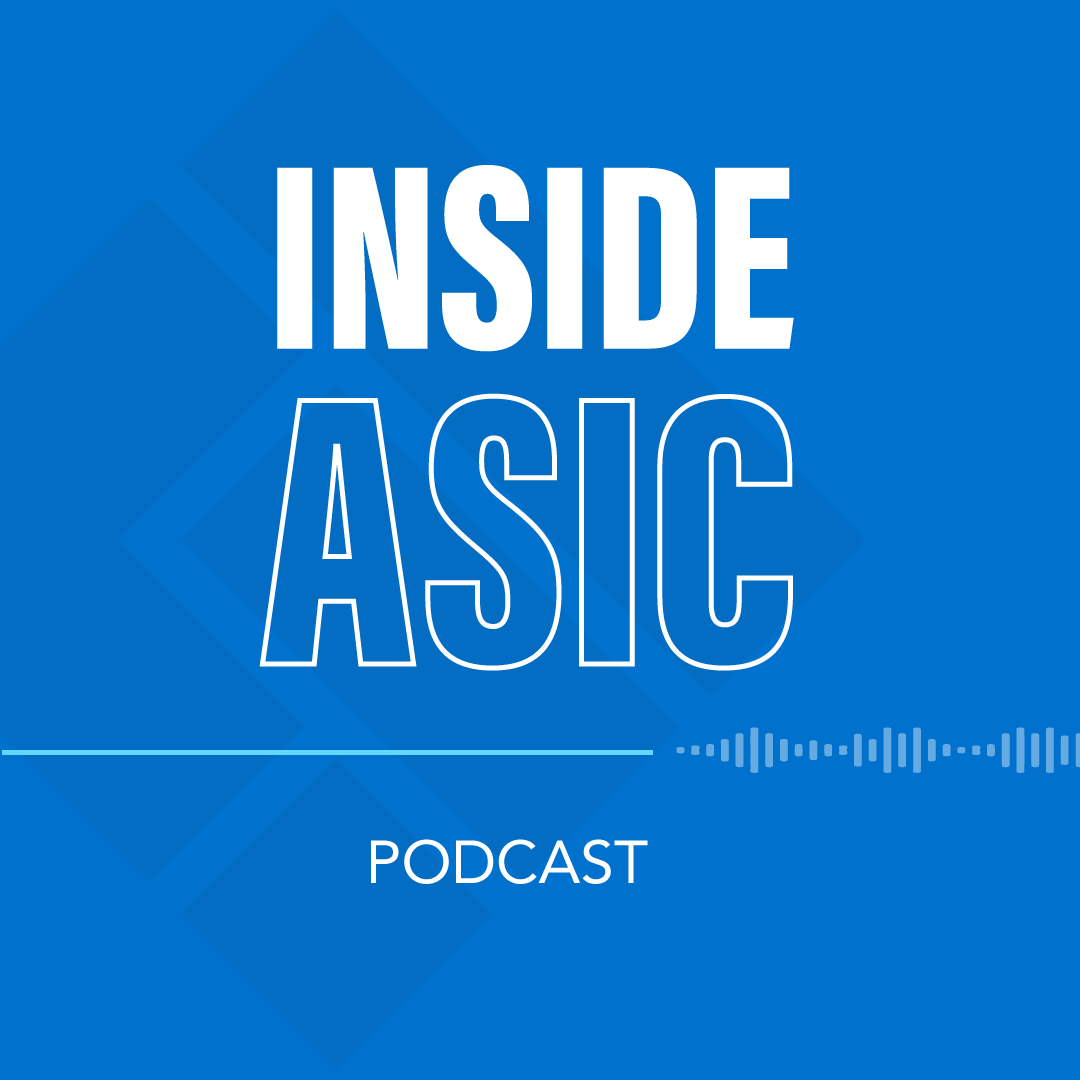
The official podcast of the Australian Securities and Investments Commission (ASIC). The Australian Securities and Investments Commission is one of the busiest law enforcement agencies in the country. In Inside ASIC we look at what it takes to keeps the financial markets and consumers safe. The podcast gives insight into the workings of ASIC and hears from the people involved. Each episode of the podcast showcases a different area of the work of our people as told by our staff, plus interviews with Commissioners and external guests. You’ll hear from key players inside ASIC on everything from protecting consumers from increasingly sophisticated scams to cracking down on greenwashing and holding super funds to account. The latest series of Inside ASIC is here: https://open.spotify.com/show/2itvIwJWHm5qhws9Z8dyiT?si=zHeqtwVdRqSHShBKZkjSZQ
Episodes

Tuesday Jul 03, 2018
Episode 41: ASIC's review of the credit card market
Tuesday Jul 03, 2018
Tuesday Jul 03, 2018
Michael Saadat, ASIC's Senior Executive Leader - Deposit takers, Credit and Insurance, joins the podcast to discuss ASIC's review into the credit card market in Australia.
Consultation Paper media release
Review into Credit Card lending media release
Transcript below:
Lara Heilbuth: Hello, and welcome to the official podcast of the Australian Securities and Investments Commission. In today's episode we'll be discussing ASIC’s review of the credit card market. My name is Lara Heilbuth and with me this time around is Senior Executive Leader of Deposit Takers, Credit and Insurers at ASIC, Michael Saadat. Michael, thanks very much for your time.
Michael Saadat: Thank you Lara.
Lara Heilbuth: So, ASIC has had a look at the credit card market – can you describe the market for us?
Michael Saadat: Yeah sure thing. We’ve done a really big review of the credit card market and the report that we’ve published has lots of really interesting information in it. But just to give you some of the highlights.
What we found as part of this review is that there were over 14 million open credit card accounts in Australia which has increased of over 300,000 since 2012. On those accounts, there’s about $45 billion in outstanding balances; and approximately $31 billion in balances on credit cards that is incurring interest charges.
Consumers were charged over $1.5 billion in fees each year, including annual fees, late payment fees and other amounts for credit card usage.
Lara Heilbuth: And what has ASIC’s review focussed on?
Michael Saadat: We had 3 main focus areas as part of our review.
The first was consumer outcomes. We wanted to identify the debt outcomes for consumers from their credit card products over time, with a particular attention to consumers who are in arrears, who carry debt at a high interest rate for a long period, or repeatedly make low repayments.
Secondly, we wanted to look at balance transfers. We looked at when and how balance transfers are taken out, the repayment experience and their effect on credit limits and debt levels over time.
And thirdly, we wanted to assess the effectiveness of key law reforms that were put in place a couple of years ago, including things like requirements for standardising how payments are allocated to outstanding balances.
Lara Heilbuth: You mentioned you looked at consumer outcomes, how bad is credit card debt in Australia? And are consumers using credit cards wisely?
Michael Saadat: What we found is that about 18% of people with a credit card are struggling with that credit card. And what we mean by that is that they are either missing payments, carrying a lot of debt or repeatedly repaying small amounts. This includes almost 550,000 people in arrears, an additional 930,000 in persistent debt and an additional 435,000 people who make repeated low repayments.
And the reason we’ve looked at this group of consumers quite closely is because credit card products can be quite expensive and if you use a credit card in a way that it is not designed then you can end up paying quite a lot of interest over quite a long period and you can take a very, very long time to pay down your debt.
And what we did was we identified that there were three groups of consumers at the greatest risk of falling into problematic debt, and that included young people who were more likely to have failed to make repayments on their credit cards; people with multiple cards were more likely to be struggling with credit card debt; and people who transfer balances are also at greater risk.
Lara Heilbuth: Ok so balance transfers have been described as a debt trap. Are they?
Michael Saadat: We looked at balance transfers quite closely as part of this review.
Balance transfers allow consumers to transfer some or all of their credit card debt from one card to another. And through the review we looked at over 1 million balance transfers.
We looked at balance transfers in detail because the Senate Inquiry into credit cards in 2015 had said that they could be a ‘debt trap’ for consumers.
And what is meant by a debt trap is when: you transfer a balance to a new card; you keep and spend on the old card; and also spend on the new card; and as a result of all of that your total debt increases.
We found that a majority of people actually reduce their debt after taking out a Balance Transfer, but a sizeable minority, around 1 in 3 consumers wind up owing substantially more debt.
The figures show that after a balance transfer, around 32% of consumers increased their debt by 10% or more and about 16% increased their debt by 50% or more which was quite concerning.
A larger proportion of people who transfer balances several times wind up with more debt. So the ‘debt trap’ risk is real for some people.
However, balance transfers can be good for consumers, particularly if they reduce the risk of building up more credit card debt by cancelling old credit cards after transferring balances, and stopping their spending on credit cards after making those transfers.
Lara Heilbuth: Given the number of people in Australia who have a credit card, what does ASIC think needs to be done to protect consumers?
Michael Saadat: For starters, we think credit providers could be doing more to make balance transfers better for consumers. And that includes through things like providing reminders to make the consumer aware when the promotional period is about to end to help them avoid paying a higher rate of interest on any outstanding debt. And this is really important because consumers might take out a balance transfer for 12 or 18 or 24 months and when that period comes to an end the promotional interest rate could go from 0% to 20%.
The second thing is we think credit providers can design products to take into account additional spending so that people are not paying higher interest on the additional spending they do do on the new card.
And finally we think that credit providers can also prompt consumers to close credit cards that they have transferred their debt from.
And on that last one, the Government’s recent reforms will make it much easier for consumers to cancel their credit cards including by requesting cancellation online and we think this is actually really positive.
We also think lenders can do more to assist consumers by taking proactive steps to address problematic credit card debt and situations where consumers are in products that don’t suit their needs, and also not allow consumers to go over their credit card limit by too much and by not allowing them to consistently go over limit with their credit card.
These are things that credit providers can already do and we saw some credit providers taking some initial steps to do this, but we think there’s much more that can be done proactively by credit providers.
The other thing to mention is that we’re consulting on a new power that we have to tighten the responsible lending laws. Under our proposal credit providers will need to check that a consumer can repay the limit on a credit card within three years.
The point of this is to make sure that people are not given too much credit up front and that the credit card debt can be manageable.
So we’re consulting and we’re looking for stakeholders to provide us with feedback on this proposal.
Lara Heilbuth: Great. So how did ASIC gather all this information to inform your review?
We gathered both quantitative and qualitative data as part of this review.
So the quantitative data we gathered, we used our information gathering powers to require 12 lenders, who cover over 95% of the market, to provide us with data on their customers over a 5 year period. We collected over 600 data points on each of the 20 million accounts that were open in the period of our review.
And what we did was that we linked the data so we could see how individuals moved balances between lenders over time, and this helped us understand the big picture.
The qualitative data we collected was also significant. We asked the 12 lenders 51 questions about their existing practices around responsible lending, hardship, the availability of balance transfers and the proactive action that they take to assist consumers.
And finally we commissioned consumer research about the use of balance transfers. This involved face-to-face and telephone interviews as well as an online survey that was completed by around 800 consumers.
The information that we gathered shows that credit card lenders should be doing more to assist consumers and we’ll be watching closely to see that lenders are in fact taking more proactive steps to help people with problematic debt and do more to make sure consumers end up with products that better suit their needs.
Consumers can also learn from our findings and help themselves by cancelling cards they are no longer using and use balance transfers in a way that actually reduces their debt.
Lara Heilbuth: So where can people go for more information?
Michael Saadat: The first place people should go is ASIC’s MoneySmart website which has lots of information and tips about using a credit card, including how to avoid costly fees and interest.
It’s a great resource to use. There’s information about balance transfers, fees and charges, how to choose a credit card and how to cancel one.
We also have an online credit card calculator that helps you work out the fastest way to pay down your debt and how much money you can save by paying it off sooner.
You can also download MoneySmart’s TrackMySPEND app which is really popular and you can track how much you’re spending on your credit card so you don’t go over your limit or end up in too much debt.
Lara Heilbuth: Thanks Michael. We’ll post links to ASIC’s report and how to find out more on the information about this podcast. And we’ll be back with another episode of ASIC’s podcast shortly.

No comments yet. Be the first to say something!